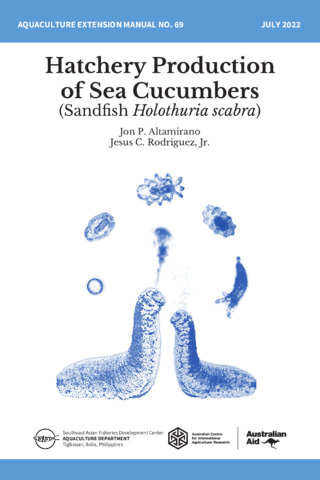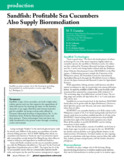Hatchery production of sea cucumbers (sandfish Holothuria scabra)
| dc.contributor.author | Altamirano, Jon | |
| dc.contributor.author | Rodriguez, Jesus C., Jr. | |
| dc.coverage.spatial | Negros Occidental | en |
| dc.coverage.spatial | Tigbauan | en |
| dc.date.accessioned | 2022-08-31T03:37:49Z | |
| dc.date.available | 2022-08-31T03:37:49Z | |
| dc.date.issued | 2022-07 | |
| dc.identifier.citation | Altamirano, J. P., & Rodriguez, J. C., Jr. (2022). Hatchery production of sea cucumbers (sandfish Holothuria scabra). Tigbauan, Iloilo, Philippines: Aquaculture Department, Southeast Asian Fisheries Development Center. | en |
| dc.identifier.issn | 0115-5369 | |
| dc.identifier.uri | http://hdl.handle.net/10862/6336 | |
| dc.description | This manual, entitled Hatchery Production of Sea Cucumbers (Sandfish Holothuria scabra) includes the consolidated methods, practical protocols and good practices in sea cucumber breeding that were established within the past decade of research and development at the small-scale sea cucumber hatchery in the Tigbauan Main Station of SEAFDEC Aquaculture Department. Hence, this manual focuses only on demonstrating the technology, requirements and procedures in operating a small to medium-scale tropical sea cucumber hatchery. This manual is written for potential sea cucumber hatchery operators, technicians, enthusiasts, researchers, and students with some basic experience and knowledge on aquaculture. However, even beginners may find this manual informative and useful, as it highlights the importance of sea cucumbers and their potential as an aquaculture commodity, particularly that of the tropical sea cucumber H. scabra, commonly known as the sandfish. This manual also serves as the primary reference material of the Training Course on “Sandfish (Holothuria scabra) seed production, nursery and management” offered by SEAFDEC/AQD. Hence, some specific descriptions of the actual facilities and existing equipment are detailed here. The manual describes the various hatchery production methodologies that were specifically optimized for the sandfish H. scabra. These methods were designed to be practical and easy to implement. The materials mentioned therein are those that can be easily procured, otherwise if unavailable, can be fabricated from common materials. The following are the main sections included in this manual: 1) Broodstock selection, collection and conditioning; 2) Natural food (microalgae) cultivation; 3) Spawning stimulation and fertilized eggs management; 4) Larval rearing and settlement; 5) Harvesting of early juveniles, packing and transport | en |
| dc.language.iso | en | en |
| dc.publisher | Aquaculture Department, Southeast Asian Fisheries Development Center | en |
| dc.publisher | Australian Centre for International Agricultural Research | en |
| dc.relation.ispartofseries | Aquaculture extension manual; No. 69 | en |
| dc.rights | Attribution-NonCommercial-ShareAlike 3.0 IGO | * |
| dc.rights.uri | http://creativecommons.org/licenses/by-nc-sa/3.0/igo/ | * |
| dc.subject | sea cucumbers | en |
| dc.subject | Holothuria scabra | en |
| dc.subject | hatcheries | en |
| dc.title | Hatchery production of sea cucumbers (sandfish Holothuria scabra) | en |
| dc.type | Book | en |
| dc.subject.asfa | sea cucumber culture | en |
| dc.subject.asfa | aquaculture | en |
| dc.subject.asfa | breeding stock | en |
| dc.subject.asfa | spawning | en |
| dc.subject.asfa | juveniles | en |
| dc.subject.asfa | economics | en |
| dc.subject.scientificName | Holothuria scabra | en |







